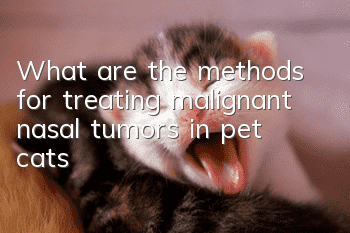What are the methods for treating malignant nasal tumors in pet cats?

How to determine whether a cat has malignant nasal tumors
Nasal malignant tumor is a very serious tumor disease. The disease usually develops from unilateral to bilateral. The cat’s nasal secretions may be bloody or pus-like. And sneezing, coughing, breathing pain, etc. often occur.
In epithelial tumors, cells are often found in clusters, and secondary infection and bleeding are common. The most common type is adenocarcinoma, other types include squamous cell acinar carcinoma and undifferentiated carcinoma; in stromal tumors, cells are exfoliated. Poor, single cells are often found with secondary infection and bleeding common, such as fibrosarcoma, chondrosarcoma, and osteosarcoma; round cell tumors are prone to exfoliation. Have unique cell morphology; lymphosarcoma and lymphoid hyperplasia, mast cell tumor, infectious tumors.
Diagnosis: Skull X-ray imaging is very helpful for diagnosis; intraoral imaging in the ventrodorsal position is the best way to detect nasal tumors; more than 70% of imaging reports of dogs with nasal tumors have increased density; turbinate destruction is common; unilateral Osteolysis.
What are the methods to treat malignant nasal tumors in pet cats
Malignant tumors in the nasal cavity of pet cats will metastasize according to different situations. This disease will cause the cat’s nasal secretions to be bloody, and the cat will feel very painful when breathing, which will make the cat’s mental state If the condition is very poor, the appetite will also be reduced, which is a very serious disease.
Due to secondary bacterial infection, antibiotic treatment may be temporarily effective. Because the disease damages local tissues, surgical treatment is not recommended. Radiation therapy is recommended for the management of most nasal tumors. Radiation therapy is relatively effective for nasal tumors in cats and dogs. Orthopedic voltage radiation therapy is slightly more effective than megaelectron volt radiation therapy, but requires surgical removal of the tumor because these therapies are less penetrating; high electron (mega)volt radiation therapy can be performed during surgery. Carry out before treatment.
Animals can receive chemotherapy; nasal cavity and nasopharyngeal tumors can be selectively treated with chemotherapy; lymphosarcoma, infectious venereal disease tumors, and mast cell tumors can be administered simultaneously with radiotherapy. The average survival time of cats with tumors is 3 to 5 months; metastasis is less common in the early stage and more common in the late stage. Complications caused by radiotherapy are diverse. Early side effects often occur, including oral mucositis, rhinitis, keratoconjunctivitis sicca, and moist dermatitis at the radiation site; late side effects (more than 6 months) occur in less than 5% of patients. occur, including corneal damage, cataracts, bone or brain necrosis.
- Cat cold and fever symptoms and treatments
- Cats can eat less and more frequently to lose weight
- The cat kept opening its mouth and panting in the car
- How to train a cat to use cat litter? What principles should be followed?
- How to stop cats from causing damage to the home, and how to train cats not to scratch the furniture?
- Will cats need to be quarantined for life if they have nasal congestion? Cat owners should pay special attention!
- Cat personality analysis, you can tell who owns what kind of cat
- How to tell if a Ragdoll cat is pregnant
- How to get rid of the odor where your cat peed
- Can cats eat spider plant leaves?



